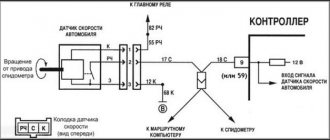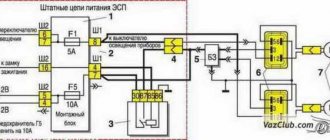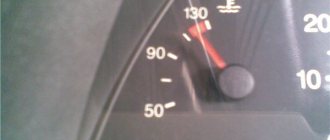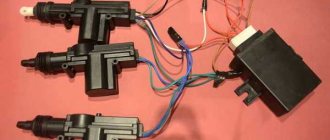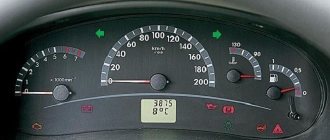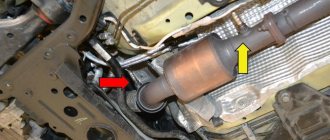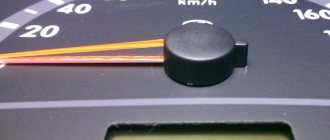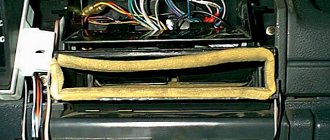Car : VAZ-2112. Asks : Alexander Glukhovsky. The essence of the question : the VAZ-2112 check light comes on and is blinking, what should I do?
On my hatchback with a fuel-injected engine, the check light started flashing. Once the effect went away on its own, then it appeared again. By the way, my engine is 1.5 liters. I heard that on a VAZ-2112 the check light can light up just like that, but in my case the light is blinking! The sound of the engine also changes. So there is a reason. Help me find her!
Why the check light on the VAZ-2112 16 valves lights up and flashes: the main reasons
Car : VAZ-2112. Asks : Alexander Glukhovsky. The essence of the question : the VAZ-2112 check light comes on and is blinking, what should I do?
On my hatchback with a fuel-injected engine, the check light started flashing. Once the effect went away on its own, then it appeared again. By the way, my engine is 1.5 liters. I heard that on a VAZ-2112 the check light can light up just like that, but in my case the light is blinking! The sound of the engine also changes. So there is a reason. Help me find her!
conclusions
Eliminating the effect when a 16-valve VAZ-2112 stalls during acceleration turns out to be not so difficult with your own hands. Of course, if you are unable to fix the problem, you should go to a car service center, where they will do everything quickly and accurately.
In the life of motorists, a situation often arises when, when driving out onto the road and trying to accelerate, it is noted that the engine does not pull.
That is, the acceleration dynamics are very “sluggish”, the car is reluctant to pick up speed, and it feels like something is holding it back.
This problem can arise with almost any car - domestic or foreign, gasoline or diesel, with a carburetor power system and injector.
Often, a drop in traction is accompanied by additional symptoms - extraneous sounds appear when the engine is running, the engine may stall in one of the modes (usually at idle), the crankshaft speed is not stable and “floats”.
Reasons for the appearance and blinking of the “check” on the VAZ-2112
If we consider engines with a volume of 1.5 liters, we can talk about one of two internal combustion engines: VAZ-2111 (8v) or 21120 (16v). In the first case, the ignition module 2111-3705010 is used, in the second - 2112-3705010. These modules are not capricious and do not often require repairs. We have already written about diagnosing the ignition module and repairing it.
Ignition system of the “tenth” family
The modules themselves, as you can see, are different, but they have the same “disease”. It is not the module that is to blame here, but its high-voltage connectors. The terminal may move away from any of the four connectors, but nothing will change externally. And after a while the terminal on the cable will burn out. Then the engine will begin to “trouble” and misfires will be noticed by the controller. Therefore, constant checking of the ignition module is necessary.
Let's clarify: at first the terminal comes off, but the current is carried out. Then charring occurs. On the dashboard of any car, including the VAZ-2112, the check will not light up immediately. And as soon as it lights up, check the contacts!
Two cases from practice
This is what happens in reality. The owners write:
- For some reason, the check light starts flashing when the speed exceeds 100 km/h;
- The lamp blinked only after warming up to 100 degrees;
- Etc.
There are many cases, but the reason is one. Contact can be disrupted by vibration, although in the first case they talk about speed. Well, thermal expansion also cannot be discounted.
What exactly needs to be done
Check the cap on each of the wires: if the copper is burnt, clean it with ASIDOL, ammonia and ordinary chalk. The taps on the module should also be cleaned. For better protection, you can apply lithium grease (Litol-24).
Here's what you can't do:
- Check for the presence of a spark by bringing a “grounded conductor” to the tap;
- Connect the “+” terminal removed from the battery to ground with the engine running;
- Apply voltage “+12” to any of the module contacts.
How to perform an express check: the key is at “0”, then we measure the resistance between taps 2-3, 1-4. Both values must match. By the way, the multimeter must be a dial gauge.
Precautions: When connecting the multimeter to the module, do not touch two probes with your hands at the same time. The measurement limit is 100 kOhm or 10 kOhm.
How to distinguish “gaps” from everything else
Let's consider the situation: it is difficult to start when hot. If it starts when cold, the check light then turns on, but after 20-30 minutes it goes out. In this case, we can conclude that there is a misfire. Well, they can even be caused by an insulation breakdown. And above we looked at what is typical for the 2112 family (but not for the 21124 engine).
This block is too smart
They may say that the check for the VAZ-2112 caught fire for no reason. This happens in cases where:
- The indicator turns on, then the engine is turned off and the battery is disconnected (disconnect the minus terminal for 10 minutes);
- After connecting the battery, no defects are observed. Start the engine - the check lamp does not light up.
In fact, the ECU actually remembers any defect (the occurrence of any error). But the “reset” is also performed by the system itself:
- When starting the engine;
- After the next test cycle.
For each error, one of two methods is used. And, in theory, there is no point in disconnecting the battery. If the “check” is constantly on, then you need to look for a defect. And “terminal tricks” usually don’t help.
Source
Kalina/Priora on-board computer errors
0102 Low level of mass air flow sensor signal 0103 High level of mass air flow sensor signal 0112 Low level of intake air temperature sensor 0113 High level of intake air temperature sensor 0115 Incorrect signal of coolant temperature sensor 0116 Incorrect signal of coolant temperature sensor 0117 Low level of temperature sensor coolant 0118 Coolant temperature sensor signal high 0122 Throttle position sensor signal low 0123 Throttle position sensor signal high 0130 Oxygen sensor signal 1 incorrect 0131 Oxygen sensor signal low 1 0132 Crankshaft sensor signal high 1 0133 Slow response oxygen sensor 1 0134 No signal from oxygen sensor 1 0135 Malfunction of oxygen sensor 1 heater 0136 Short circuit to ground of oxygen sensor 2 0137 Low level of oxygen sensor 2 0138 High level of high signal of oxygen sensor 2 0140 Open circuit of oxygen sensor 2 0141 Malfunction of oxygen sensor 2 heater 0171 Too lean mixture 0172 Mixture too rich 0201 Injector 1 control circuit open 0202 Injector 2 control circuit open 0203 Injector 3 control circuit open 0204 Injector 4 control circuit open 0261 Injector 1 circuit short to ground 0264 Injector 2 circuit short to ground 0267 Injector circuit short to ground sunki 3 0270 Short to ground in the injector 4 circuit 0262 Short to 12V in the injector 1 circuit 0265 Short to 12V in the injector 2 circuit 0268 Short to 12V in the injector 3 circuit 0271 Short to 12V in the injector 4 circuit 0300 Many misfires 0301 Misfires in cylinder 1 0302 Misfire in cylinder 2 cylinder 0303 Misfire in cylinder 3 0304 Misfire in cylinder 4 0325 Open circuit of knock sensor 0327 Low level of knock sensor signal 0328 High level of knock sensor signal 0335 Incorrect crankshaft position sensor signal 0336 Crankshaft position sensor signal error 0340 Phase sensor error 0342 Neither low signal level phase sensor 0343 High signal level of the phase sensor 0422 Low efficiency of the converter 0443 Malfunction of the canister purge valve circuit 0444 Short circuit or break in the canister purge valve 0445 Short to ground of the canister purge valve 0480 Malfunction of the cooling fan circuit 1 0500 Incorrect speed sensor signal 0501 Not correct speed sensor signal 0503 Interrupt speed sensor signal 0505 Idle speed control error 0506 Low idle speed 0507 High idle speed 0560 Incorrect on-board power supply voltage 0562 Low on-board power supply voltage 0563 High on-board power supply voltage 0601 ROM error 0603 External RAM error 0604 Internal RAM error 0607 Knock Channel Malfunction 1102 Low Oxygen Sensor Heater Resistance 1115 Faulty Oxygen Sensor Heater Circuit 1123 Rich Idle 1124 Lean Idle 1127 Rich Partial Load 1128 Lean Partial Load 1135 Oxygen Sensor Heater Circuit 1 open, short circuit 1136 Rich mixture in Light Load mode 1137 Lean mixture in Light Load mode 1140 Measured load differs from calculation 1171 CO potentiometer low level 1172 Potentiometer CO level high 1386 Knock channel test error 1410 Canister purge valve control circuit short circuit to 12V 1425 AD purge valve control circuit sorber short short to ground 1426 Control circuit of the canister purge valve open 1500 Open circuit of the control circuit of the fuel pump relay 1501 Short to ground of the control circuit of the fuel pump relay 1502 Short circuit to 12V of the control circuit of the fuel pump relay 1509 Overload of the control circuit of the idle speed regulator 1513 Circuit of the idle speed regulator short circuit to ground 1514 Idle air control circuit short circuit to 12V, open 1541 Fuel pump relay control circuit open 1570 Incorrect APS signal 1600 No communication with APS 1602 Loss of on-board voltage to the ECU 1603 EEPROM error 1606 Rough road sensor incorrect signal 1616 Rough road sensor low signal 1612 Reset error ECU 1617 Rough road sensor high signal 1620 EPROM error 1621 RAM error 1622 EPROM error 1640 EEPROM Test error 1689 Incorrect error codes 0337 Crankshaft position sensor, short to ground 0338 Crankshaft position sensor, open circuit 0441 Air flow through the valve is incorrect 0 481 Cooling fan circuit malfunction 2 0615 Starter relay circuit open 0616 Starter relay circuit short circuit to ground 0617 Starter relay circuit short circuit to 12V 1141 Malfunction of the oxygen sensor 1 heater after the converter 230 Malfunction of the fuel pump relay circuit 263 Malfunction of the injector driver 1 266 Malfunction of the force driver nki 2 269 Malfunction of injector driver 3 272 Injector driver fault 4 650 CheckEngine lamp circuit fault
Error code: Where is the diagnostic connector located in the Lada Granta car; full review
Why does the VAZ 2112 engine suffer from injector problems? Let's look at the 16 valve version. Mechanic's opinion.
One of the most frequently asked questions from owners of domestic cars is why the VAZ 2112 engine has a 16-valve injector. This is quite common. Moreover, there may be several reasons, and finding them is quite difficult. At a minimum, you need to know where to look for the problem. If you ask any motorist about the reasons for this phenomenon, you can hear a variety of advice. But often they are all one-sided. And you need to approach the search purposefully, checking all possible options. Only then will you be able to reliably find the fault and fix it. First, decide on the symptoms of “motor tripping”...
What else do you need to think about?
We were able to describe several of the most frequently repeated cases of this signal lighting up. The engine designs of different cars differ, so there may be other reasons for the appearance of an alarm signal. It will be best for you and your car if computer diagnostics of all car systems is carried out. To do this, you can use the services of specialized centers, but some “advanced” drivers do this on their own.
Pay more attention to your “iron horse”, use only high-quality fuel and consumables, then you won’t have to worry about why the check light comes on when driving. And if you do see an “alarming” signal, do not rush to extremes, but delve into the problem and eliminate it.
Why the check light on the VAZ-2112 16 valves lights up and flashes: the main reasons
Car : VAZ-2112. Asks : Alexander Glukhovsky. The essence of the question : the VAZ-2112 check light comes on and is blinking, what should I do?
On my hatchback with a fuel-injected engine, the check light started flashing. Once the effect went away on its own, then it appeared again. By the way, my engine is 1.5 liters. I heard that on a VAZ-2112 the check light can light up just like that, but in my case the light is blinking! The sound of the engine also changes. So there is a reason. Help me find her!
Possible reasons for the check function to light up
Check engine light came on during hard acceleration
This function is responsible for the operation of the engine and if it signals, then there may be problems in the operation of this particular unit. Of course, this is scary for any motorist, because repairing the power unit is complex and expensive. But don’t immediately get scared and panic, the reason may be petty.
So, let’s look at what are the reasons why the “CHECK” function on the Lada Grant came on:
- If the indicator lights up when you start the engine, then don’t worry, everything works.
- If the “CHECK” lights up and signals for a long time, then, first of all, it is necessary to make a diagnosis, and only then worry.
- If there is a “CHECK” while driving, this may mean that the oil level in the engine is insufficient (p0523 - error when the oil pressure sensor is faulty).
- The “CHECK” function is on - it’s worth checking the engine for signs of depressurization or oil leakage.
- If the above reasons do not work, but the “CHECK” is lit, then this may be a signal that the spark plug has failed or low-quality fuel has been filled.
Elimination methods
Let's consider some options for eliminating the causes of the “CHECK” function fire on the Lada Grant:
- Bad fuel. The elimination method is quite simple - drain the low-quality fuel and fill in new one. Let the engine run a little and turn it off. If everything is normal, then upon startup, the signal will disappear. AvtoVAZ recommends refueling with 95 gasoline, but it often causes errors and complaints about its quality. What kind of gasoline do you fill up with, 92 or 95?
- Spark plugs and high-voltage wires. Unscrew all spark plugs and check the gaps and the presence of a spark. Replace faulty spark plugs and wires.
Engine 21116 (high-voltage wires, oil dipstick)
4 bolts securing the plastic fuel pump cover under the rear seat
The faults that you can fix yourself are indicated, but if nothing works, you should contact a car service.
Underwater rocks
If the “CHECK” light comes on on the Lada Grant, then do not panic. Often on cars the signal is supplied from a common ECU, which, like any computer, can malfunction. This may be caused by a short circuit or replacement of electrical circuit components. Therefore, errors occur in the electronic control unit, which can serve as a “CHECK” signal.
The ECU in Grant is not located very well, and if your check light came on during or after rain, then water could have gotten into it due to design features.
The ECU is located under the glove compartment
This problem can be treated quite simply. The ECU itself needs to be connected to a software laptop and errors in the system should be corrected or outdated firmware changed. It is best to entrust this operation to specialists who know how it is done.
Resetting an error without using an adapter (collective farm method)
If you are sure that the check engine light is “temporary”, that is, the quality of gasoline is poor, or the spark plug was faulty, which has already been replaced with a working one, then the check engine light can be reset manually without using an adapter; there are two ways.
- To do this, disconnect the terminal for five minutes, the memory in the electronic engine control unit (ECU) will be reset, and the on-board computer readings will also be reset.
- There is a second way, you just need to remove the cigarette lighter fuse; Grant's design engineers installed an immobilizer on it.
Main reasons
Why does the VAZ 2112 engine have problems with the 16 valve ? This phenomenon may be a sign of a malfunction of several systems at once. Therefore, it is impossible to answer this question unambiguously. When searching for a problem, you will need to check the following systems:
- Ignition;
- Nutrition;
- timing (valve);
- Piston group;
- Sensors and ECU.
The check can be performed in any order. It's better to start with diagnostics. Very often this helps to narrow down the search to one system. Therefore, do not neglect this method of troubleshooting.
Diagnostics of spark plugs by plaque
When the engine starts cold or hot, you can check the carbon deposits on the spark plugs. If the coating is white, then this indicates a lean mixture and overheating of the engine. A black tint indicates a rich mixture. In both the first and second cases there are problems with the operation of the electronics. This is either installing new firmware, or replacing the ECU. A normal candle has a brick color. By the way, the engine may stall at idle if the part is damp. This also significantly increases the warm-up time. In addition to the spark plugs, the ignition coil may also be acting up. Priora (8 valves) is equipped with distributor ignition. Overheating of the coil is often observed. You can restore the operation of the motor by simply replacing the element.
The engine stalls when hot: reasons
To determine the main reasons, you need to know the design features of the power unit. Thus, not all motorists are able to identify the cause and also repair the breakdown on their own. Therefore, if the owner of the power plant doubts his abilities, it is recommended to contact the car service directly.
Is the engine running hot? Let's determine the main causes and nodes of the problem:
- Problems in the ignition system. This includes spark plugs, high-voltage wires, as well as the ignition coil and switch.
- Formation of an air-fuel mixture. In this category, the cause will be the fuel and air filter, carburetor or injector.
- Wear of the engine, namely components such as piston rings, valves or valve stem seals.
- The presence of air leaks for one reason or another.
- Malfunctions associated with broken sensors or errors in the motor control unit.
What's the result?
As you can see, if the engine stalls and the check engine light blinks, it is necessary to determine the cause as quickly as possible. A timely call for service or repairs will allow you to avoid subsequent troubles with the catalyst and lambda.
It must be remembered that tripping and misfires do not always indicate a serious breakdown. In some cases, it is enough to replace the spark plugs or explosive wires, while in others the engine still needs to be repaired.
In this case, the spark on the candles will be normal, the injectors will also supply fuel, the compression measurement will not reveal any deviations from the norm, but the “check” in this case will still blink or blink.
The main signs by which you can determine problems with the DPKV crankshaft position sensor. Causes of failures, breakdowns, self-check.
When you sharply press the gas pedal, the engine jerks, jerks and dips appear, the car does not pick up speed: the main causes of the malfunction and diagnostics.
For what reasons may misfire of the fuel-air mixture occur in one or more cylinders? Fault diagnosis, recommendations.
Why does the check light light up on the dashboard? Is it possible to continue driving a car if the check engine light is on? What should you check first?
Why the engine may not pick up speed: gasoline engine, diesel unit, car with LPG. Fault diagnosis, useful tips.
The engine does not start after washing the engine: the main reasons why the power unit cannot be started. What can be done in such a case.
Ignition
Before checking the entire system, it is necessary to identify the inoperative cylinder. This is done as follows: the high-voltage wires are pulled off the spark plugs one by one.
At the same time, the working cylinders react to this action, the engine begins to wither. If the non-working cylinder is disconnected from the ignition, the engine will not react to this in any way. After determining the inoperative cylinder, unscrew the spark plug. Problems with it or with the ignition system are indicated by the presence of fuel residues on it, the spark plug is “wet”. You can try replacing the spark plug and installing another high voltage. You may find that when you start the engine, it runs fine. If this does not happen, you need to continue checking. The simplest solution is to replace your module with one that is known to work. If this is the problem, then the engine should start working correctly. You can also check with a multimeter . To do this, you need to measure the resistance at the terminals. This needs to be done in pairs. Combine cylinders 1 and 4, as well as cylinders 2 and 3. The resistance should be between 5.2 and 5.5 ohms. The ignition module cannot be repaired; if it malfunctions, it will have to be replaced.
Communities Lada Priora Lada Priora Club Blog Trouble check and blinking
So, we figured out the general scheme. Now let's look at what problems lead to the check light coming on and the engine stalling. Often a p0300 error occurs, which indicates that a misfire (misfire) is occurring. There are several reasons for these omissions, and to determine them it is necessary to carry out a step-by-step diagnosis, taking into account certain individual symptoms. You should start by checking the ignition system. The most common cause of tripping is the failure of spark plugs and armored wires. Candles can wear out their service life, break down, or become heavily contaminated. Armored wires suffer from insulation damage and breakdowns. One way or another, the result is either no spark at all, or there is a spark, but it’s weak.
If everything is in order with the spark plugs and wires, you should pay attention to the ignition module or ignition coils, which may be shorting. In this case, it is better to entrust the check to experienced specialists, since unprofessional actions lead to the fact that you can burn the switch or damage other important elements. It should also be added that you need to carefully inspect the spark plug wells themselves.
Quite often, the engine fails if water accumulates in the wells or engine oil gets there. In some cases, lubricant gets into the wells due to problems with the valve cover gasket
It should also be added that you need to carefully inspect the spark plug wells themselves. Quite often, the engine fails if water accumulates in the wells or engine oil gets there. In some cases, lubricant gets into the wells due to problems with the valve cover gasket.
Having dealt with the ignition system, it is necessary to check the power system. As a rule, incorrect operation of injection nozzles or malfunctions in their operation lead to engine tripping. At the same time, the check will light up or flash.
We also recommend reading the article about what misfires in engine cylinders are. In this article, you will learn about the causes of misfires and errors, as well as how to identify and fix the problem.
The best option would be to check the injectors on a special stand. Such diagnostics allows you to determine the need to clean, repair or replace injectors. At the same time, specialists check the power supply to the injectors, the condition of the injector O-rings, etc.
As for compression, a burnt-out valve often leads to an unexpected decrease in the indicator. If the valve burns out, the engine starts to run rough. In this case, tripling is constant and occurs in all modes of engine operation. Engine thrust drops significantly, and significant excess fuel consumption is observed.
Please note that in this case you cannot drive the car, as there is a high risk of damaging the catalyst and oxygen sensor (lybda probe). To confirm the diagnosis, you need to measure the compression, and to solve the problem itself, you need to remove the cylinder head, troubleshoot the head and change the valve.
When is it time to check the engine?
The engine should always run like a clock, that is, smoothly and without jerking, failures, or jumps. At idle speed it is easy to notice that the engine is unstable. When such suspicions creep in, it is better to raise the hood and listen to the beats in all cylinders. “Troit” means one or two cylinders are inactive, since there are no conditions necessary to ensure the processes in their combustion chambers. As a result, the actual power of the power unit drops noticeably and gasoline consumption increases. There is also a tendency to stall, for example at intersections, at traffic lights or while warming up. At the same time, when the engine of a VAZ 2110 fails, the reasons for such a malfunction can be different.
You can find out which cylinder has problems in one simple and long-known way. With the engine running, you need to remove the high-voltage wire from each spark plug one by one. If the cylinder was working properly before, then when it is turned off there will be a noticeable dip and a drop in speed (look at the tachometer scale). If there are no changes after removing the wire from the spark plug, we can safely assume that the problem is precisely in this cylinder - it was not working before the shutdown.
Is it possible to drive with the check light on?
It is impossible to give a definite answer to this question, because everything depends on the severity of the breakdown. If you know the error code and you know for sure that the faulty sensor will not affect the operation of the engine, then you can drive the car for a while until it becomes possible to fix the problem.
However, it should be borne in mind that driving in emergency mode increases fuel consumption, since its quantity has increased to maintain stable operation. In this regard, it is not recommended to move around with a “check” for too long.
Hi all. This entry will be about a problem that appeared to me exactly a year ago, namely, when I turn the key to position 1 (turn on the ignition), all the gauges (battery, oil, parking brake) on the dash light up normally, and the CHECK ENGINE icon lights up very dim, then either it just lights up normally from waiting, or turn the ignition on and off several times. At first I turned to my friends, they told me that maybe some dachik was out of order, so she was acting up, I pulled all the wires, after I picked the wire that goes to the idle speed sensor, the check light came on normally, after which always when the check light was dim, I pulled this wire and everything helped.
But then I bought a new idle speed sensor, after which such whims stopped. Happy, I continued to use my car, but my joy did not last long, after about a week or a week and a half the same problem appeared again, only twitching the wire on the idle speed sensor no longer helped ((. Since the idle speed did not float, which indicated that The sensor is normal, it was necessary to look for another - the real reason.
Here I have already turned to the World Wide Web for help. Where did I find the information that this behavior is typical for poor contact “open circuit” and most likely it’s a matter of mass. Then I found an article about all the masses in the VAZ 21124, halfway I went to check and changed where it was doubtful, except for the mass of the fuel pump (it’s difficult to get to it, you have to disassemble the torpedo).
The whims went away again for about a week, but as you might guess, this is not the reason. Then I began to think about the last option known to me, the mass of the fuel pump (which fits the rear left bolt of the parking brake lever (handbrake)). When the check did not light up, I actively shook the handbrake in order to get good contact by turning, and this helped.
Then I managed to see this mass without looking at it and get a little closer to it. It was located in the letter G: the terminal was the upper part of the letter, and the wire ran away from it perpendicularly - like the lower part of the G. A galled wire was visible near the terminal, I thought that there might be a loss in this.
After such an observation, when the check engine did not light up, I simply straightened the wire with my finger or a screwdriver and you won’t believe it, it led to success. and in the end, when I was making noise on the floor, I strengthened this wire, insulated it, treated the bolt hole with water, cleaned it of rust, applied a layer of grease for better contact, and then my torment ended, but again only for a week (. After all this, I thought that My fuel pump is going bad, it’s sad news, but in order not to throw away money, I decided to go for diagnostics.
but this is not a constant problem, the car either starts or doesn’t, if I come for diagnostics and the check light lights up normally and the car starts, I’ll throw away money for diagnostics and they will tell me that everything is fine with you. Then a friend suggested that his brother look at the car; he is an electrician and knows a lot about cars. Well, I have nothing to lose, it can’t get any worse, we came to their garage, he checked all the masses, said that everything was fine with them and we needed to look at their brains.
You won’t believe it, the reason for such whims when turning on the ignition was surprisingly funny. nothing went wrong, all the sensors and masses were in order, but the problem was in the brain launcher, it was stuck out halfway (most likely from shaking on our “wonderful” roads). I was lucky that the contacts didn’t burn, the relay was intact, there was no contact oxide, no damage.
put it back in place and checked everything was fine. I've been riding for 2 weeks now and the problem with the dim check has never reoccurred.
So if such a problem arises, keep in mind that the cause could be everything that is described in this entry, you should not neglect checks and think that this can only be because of the relay, check it won’t make things worse! Good luck on the roads and less problems and vagaries from your iron horses))
- carfrance.ru
- avtonovosty1.ru
- www.drive2.ru
What are the dangers of “tripleting”?
When the engine runs on three out of four cylinders, not only does the engine power decrease, there is excessive fuel consumption, the smell of gasoline comes out of the exhaust system, and the trembling and trembling of the engine simply makes it difficult to feel comfortable inside the car. However, the troubles don't end there.
Possible reasons
In most cases, when the cylinder does not work, the culprit is one of the elements of the ignition system, which is responsible for igniting the fuel, or the injectors responsible for supplying the fuel.
The ignition system must be checked in the following order:
- Open the hood with the engine running and try to remember the timing of its operation by ear.
- Next, in order of priority, we inspect and then disconnect the high-voltage wires from the spark plugs.
We disconnect each wire from the spark plug in turn. (Example on an 8-valve engine).
A crack in the spark plug body is the reason for replacement.
Using this table, it is very easy to determine the condition of the candles.
If there is “smoking” or heavy carbon deposits on the spark plug, this prevents its stable operation; in this case, the spark from the spark plug is very weak or absent altogether. It is not enough to clean the spark plug or replace it with a new one; you need to find the cause of this phenomenon. Check whether the spark plug is selected correctly and whether it has the correct gap.
Dirty candle with an oil trail.
It is best to check the spark plug for the presence of a spark on a special stand, or on your own.
If a spark does not appear when checking the spark plug, or it is very weak, this may indicate the following problems:
- Replacement of high-voltage wires is required.
- Diagnostics required for the electronic control unit.
- The timing belt has moved several teeth due to insufficient tension. Read this article about how to replace it.
Remember that for the best and most thorough check and the cause of engine tripping, you can find out by doing engine diagnostics.
Replace the oxygen sensor (lambda probe)
The oxygen sensor in your car is part of the exhaust system that monitors how much oxygen is not burned in the engine combustion chamber. This sensor helps control the vehicle's fuel consumption. A malfunction of the oxygen sensor (lambda probe) means that the car computer does not receive the correct data and can significantly increase fuel consumption, and at the same time reduce engine power. Most cars have 2 to 4 oxygen sensors. If you have a home car error scanner, then by connecting it to the car you can easily find out which sensor needs to be replaced.
For what reason does the oxygen sensor in a car become unusable: - Over time, the sensor becomes covered with a layer of used and regular motor oil (oil soot), which reduces the accuracy of reading sensor readings for regulating the gasoline mixture and distributing optimal fuel consumption. A malfunction of the oxygen sensor in a car leads not only to increased fuel consumption, but also to an increased content of harmful CO2 substances in the exhaust.
What needs to be done: -If you do not change a faulty car oxygen sensor, this may lead to failure of the car catalyst (it may burst), which will result in expensive repairs for you. The cost of new catalysts is very high due to the precious alloys they contain. Some cars have several of these catalysts at once and their cost can reach up to 90 thousand rubles. So gentlemen, don’t delay replacing the oxygen sensor. Although replacing the sensor itself and its cost are decent, it is still not commensurate with the cost of the exhaust gas catalyst system itself. You can save money on replacing this sensor by doing it yourself. Many car manuals have detailed instructions on how to replace the oxygen sensor yourself. If you know where the oxygen sensor is located, then it will not be difficult for you to disconnect the faulty lambda probe and replace it with a new one. Remember that you cannot delay replacing this important element!
Valves and piston
These systems are tested together. First you need to remove the breather hose from the manifold. If white smoke comes from it, then the cause of the cylinder failure is definitely the piston. You should disassemble the engine and see what happened.
Most often, the rings are stuck; to eliminate them, you will have to remove the pistons. If smoke , or it is almost colorless, then the problem is in the valves. First, let's measure the compression. If it is less than 11, then the diagnosis is a burnt valve. You will have to remove the head, change the valve and grind it in. If everything is fine with compression, remove the engine cover and check the valve adjustment. The engine can fail either because the valve is tight or because it is too loose. In any case, they need to be adjusted.
In-depth search for possible faults
At idle, the engine “trips” is caused by the presence of the ring. It is easy to confirm this malfunction. Simply remove the breather hose from the manifold. The presence of even a little white smoke indicates a problem in the piston system. Further repairs and diagnostics involve disassembling the motor.
The further procedure is as follows:
- measure the compression level of the valves;
- a burnt-out valve as the culprit of the malfunction will confirm the measurement result from 0 to 10;
- remove the head and replace the valve;
- wipe the valve;
- make the necessary adjustments to the valve system;
- make sure there are no jammed valves.
It is much less common to blame the crankshaft low sensor for deviations in operation. You can check this by removing the device from the car.
Before dismantling, it is necessary to fix its original location so as not to make a mistake when reinstalling it. After this, the resistance level of the inductive coil is measured.
The recommended value level ranges from 550 to 750 Ohms. Deviations upward or downward indicate the need to replace the sensor. You cannot delay this, otherwise one problem, like dominoes, will provoke a number of others.
VAZ 2112 strange case
#1 maxim_001
#2 liner
The leakage current is too much! up to 100mA = normal, higher, no longer normal!
The check is still a light bulb or LED.
It’s worth trying it on directly on the “receipt” itself. relative to the mass on both sides. The voltage difference gives rise to light. the difference can be quickly localized; it can be either the lock itself or the alarm interlocks (if any) located in the lock circuits. from the ECM side, only the controller and its power circuits. Well, and more connectors.
#3 iai
#4 Evgen
#5 maxim_001
#6 AVA
Diagnostics, repair, updating and modification of automotive equipment. viber +79697788671
- Top
- Nickname or quote
- APC ADACT
- → Diagnostics
- → Domestic cars
- Forum Rules
ARS ADACT develops firmware for chip tuning of gasoline and diesel engines. Ready-made calibrations for any task are available in the official store: more than 60 brands and 300 models, for LPG, with the transition to other Euro standards and preservation of factory ones. If there is no ready-made firmware, you can order individual calibration for any task.
ADACT firmware can only be purchased in the store on the official website. Their distribution is protected using a SenseLock key and a user activity rating system. Any other sites offering ADACT firmware present their own unverified work as calibrations from our company.
Problems in the injector
We will consider injector malfunctions associated with engine tripping using the Lada engine as an example. In this case, the most likely cause is the injectors. Clogging of one of the parts can lead to an imbalance in the air-fuel mixture. This effect is called a “lean” mixture, since there is not enough fuel for normal ignition. It is for this reason that the VAZ engine (injector) is tripping.
To fix the problem, you need to dismantle the car's injectors and carry out diagnostics using a special stand that will show which part has failed. You can do the diagnostic operation yourself. To do this, you will have to remove the fuel rail, but do not disconnect it from the power system. After turning on the fuel supply pump, you will see which of the injectors is spraying fuel incorrectly. Thus, having identified the faulty element, it is worth replacing it and eliminating the reason why the VAZ engine stalls when hot.
What else do you need to think about?
We were able to describe several of the most frequently repeated cases of this signal lighting up. The engine designs of different cars differ, so there may be other reasons for the appearance of an alarm signal. It will be best for you and your car if computer diagnostics of all car systems is carried out. To do this, you can use the services of specialized centers, but some “advanced” drivers do this on their own.
Pay more attention to your “iron horse”, use only high-quality fuel and consumables, then you won’t have to worry about why the check light comes on when driving. And if you do see an “alarming” signal, do not rush to extremes, but delve into the problem and eliminate it.
Why did the engine start to stall? – The most complete analysis of the reasons
What does the term “Engine Troit” mean?
I ask this question at the beginning of the article in order to cut off the “couch experts”, and only real car enthusiasts who love and appreciate their car remain here.
Just one of the commentators began to assert:
“Engine tripping is when there is no one cycle in the operation of an internal combustion engine. That is, out of four cycles of engine operation, one cycle was thrown away.”
I explained to him that he was wrong, but he didn’t get it. To prevent such armchair army specialists from wasting their time and “cracking” in the comments, I want to cut them off right away.
The VAZ 2114 engine is shaking and misfiring, the check is on fire (repair and diagnostics)
Engine VAZ 2114
injector. hard to start, wobbles and crashes
at idle speed,
check engine light is on
- Start the engine and open the hood.
- Determine how the engine operates and remember the sound it makes.
- Remove the wires from the spark plugs one by one. If the sound does not change, the cylinder is faulty. If the operating mode of the motor becomes different, the unit is operational.
Further diagnosis is carried out based on the condition of the spark plug from the faulty cylinder. It is turned out with a special key, which every car owner needs to have. It is impossible to change it for another. To get to the service center, you need to replace the carbonated spark plug with a new one to temporarily restore engine performance.
See:
- If the electrode on the removed spark plug is clean, but the head is dirty, then this means dust has formed in the combustion chamber. In this case, you need to check the air accounting system and, if necessary, change the filter.
- Burnout of the electrode and contamination of the entire spark plug with soot indicates a depletion of the fuel consistency and detonation combustion. If the electrode is intact, but there is burning on the entire spark plug, it is clear that the consistency is too rich and the ignition is delayed.
Many car enthusiasts are familiar with the method of checking spark plugs. If it is there, even if it is weak, then you need to find additional reasons for the occurrence of a motor malfunction, and if it is good, there is an option to try starting the engine again, maybe its operation has been restored. If there is no spark, replace the spark plug with a new one.
If the check engine light comes on: 5 most common reasons for the “Check engine” light to turn on
Many of us friends have probably encountered such a problem as turning on the engine icon (“Check engine”), the appearance of which on the car dashboard scares drivers.
Today we invite you to familiarize yourself with the 5 (five) most common reasons why the check engine light comes on on the dashboard. The appearance of the engine indicator icon on the dashboard usually occurs without warning. The reason for the appearance of this “Check Engine” cannot be immediately understood. Even if the car has auto diagnostics (for example, in cars such as BMW, Audi, Porshe, Mercedes-Benz, VW), which scans all car systems for errors and their presence, displaying decryption information on the instrument panel, such reasons for the appearance The engine checks will not be deciphered. For most drivers, the appearance of this warning icon on the instrument panel means the need to urgently go to a car repair shop for diagnosis and to eliminate the reason why the “Check Engine” warning icon appeared. But in fact, in most cases, when the “Check” indication appears, you can independently diagnose the cause of the engine failure, and in some cases it is even possible to eliminate this cause yourself without a trip to a car service center, which will certainly save you money.
Check the fuel filler cap
Many drivers, in some cases, when the “check engine” indication appears, begin to think about serious problems with the engine; they do not even think of checking the tightness of the fuel system, which may be compromised due to a defect or an insufficiently tightened fuel tank cap. This is a very common reason for the appearance of the “Check” engine icon.
Reason for the error: - Leakage of the fuel system due to the passage of air through the filler cap of the fuel tank, as well as an increase in the fuel consumption of the vehicle, for which the vehicle’s diagnostic system will definitely display an engine error by turning on the “Check engine” indication on the vehicle’s instrument panel.
What needs to be done: -If when the “Check” indication appears, your car has not lost its power and there are no audible signs of engine damage (knocking, humming, creaking, etc. in the engine), then the first thing you need to do is check the gas tank for leaks. Your gas cap may be cracked or not tightened enough. If the gas tank cap was not tightened enough, then after tightening it all the way, you can continue driving the car for a while, and then look at the dashboard and see if the engine error disappears. To prevent the check engine light from appearing and lighting up, check the fuel filler cap regularly. Remember also that periodically this cover must be replaced with a new one!
Reason one - spark plugs
I wrote in detail about how to determine faults in car systems using spark plugs
here .
I recommend reading it - it turned out to be useful, judging by your reviews, thank you.
We unscrew the spark plugs one at a time and look at their insulator.
If it is covered with dense carbon deposits, then it is difficult for a spark to penetrate it. The current seeks the path with the least resistance, so the spark will not be between the electrodes, but will “go” along the insulator to the side. Its energy will not be enough to set fire to the air-fuel mixture. This cylinder will not work.
We inspect the external condition of the spark plug insulator.
If there are microcracks, then part of the current will not be converted into a discharge, but will escape through these damages. You need to look at the internal insulator, which is screwed into the cylinder head, and at the external one, onto which the armor wire cap is placed.
Any chips or damage can lead to poor sparking or its complete absence.
Large or small gap between electrodes.
Many people have heard or know that for certain engines, ignition systems and types of fuel used, spark plugs with a certain gap are required. Usually its value is indicated by the manufacturer of engines and cars.
Recommendations
Comments 14
In general, 2 weeks ago I had the same song... And the car is also 2003. In general, yes. I thought the worst too. I was looking for a diagnostician. But first I checked the marks, everything is ok. And the same crap. not noticeable on the first one. Perfect at idle. It doesn’t move until 2000 rpm, but from 2000 it pulls it out from under you. I'll go to the diagnostician. Luckily I got a normal guy. I didn’t bother to pull my mu by the front. I immediately removed the armor wires, took out a tester and measured the resistance. It wasn’t on two wires at all, but on two wires it was 7th. I couldn’t believe my ears. For the New Year, I changed the spark plugs and wires. They're still new. And the dick is there. They sell a lot of shit in stores. changed the wires. bought for 1000 rubles. The problem went away immediately. So far it's driving fine. But I immediately gave up the candles as a preventive measure. Check the resistance on the wires.
Thank you. Let's check it out. what should the resistance be?
well...I have 7 ohms. showed. And there, who the hell knows what the ideal is.

